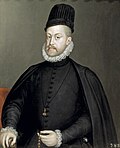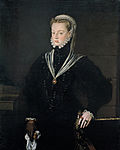Charles V, Holy Roman Emperor
| Charles V | |
|---|---|
| Imperator Romanorum (more...) | |
 | |
| Holy Roman Emperor (more...) | |
| Reign | 28 June 1519 – 24 February 1558[a] |
| Coronation | |
| Predecessor | Maximilian I |
| Successor | Ferdinand I |
| King of Spain as Charles I | |
| Reign | 14 March 1516 – 16 January 1556 |
| Predecessor | Joanna |
| Successor | Philip II |
| Co-monarch | Joanna (until 1555) |
| Regents | |
| Archduke of Austria as Charles I | |
| Reign | 12 January 1519 – 21 April 1521 |
| Predecessor | Maximilian I |
| Successor | Ferdinand I[b] |
| as Charles II | |
| Reign | 25 September 1506 – 25 October 1555 |
| Predecessor | Philip the Handsome |
| Successor | Philip II of Spain |
| Governors | See list |
| Born | 24 February 1500 Prinsenhof of Ghent, Flanders, Habsburg Netherlands, Holy Roman Empire |
| Died | 21 September 1558 (aged 58) Monastery of Yuste, Crown of Castile, Spain |
| Burial | El Escorial, Spain |
| Spouse | |
| Issue more... | |
| House | Habsburg |
| Father | Philip the Handsome |
| Mother | Joanna, Queen of Castile and Aragon |
| Religion | Catholic Church |
| Signature |  |
Charles V (24 February 1500 – 21 September 1558) was Holy Roman Emperor from 1519, King of Castile and Aragon from 1516, and Lord of the Low Countries as Duke of Burgundy from 1506.
Philip the Handsome (son of Maximilian I of Austria and Mary of Burgundy) and Joanna the Mad (daughter of Ferdinand II of Aragon and Isabella I of Castile) were his parents. He ruled Austria, Spain, Two Sicilies, Sardinia, Germany, Belgium, Holland, Luxembourg, Hungary, Bohemia, Croatia, Mexico, Peru, and Venezuela.
His Majesty or His Imperial Majesty was first used when he was king. His Empire became large and was known as "in which the sun does not set". He was also known as "The Emperor of Universal Dominion."
He divided his empire between his brother Ferdinand I, Holy Roman Emperor and his son Philip II of Spain.
Issue
[change | change source]Charles and Isabella had seven legitimate children, but only three of them survived to adulthood. Charles also had natural children before he married and after he was widowed.
| Name | Portrait | Lifespan | Notes |
|---|---|---|---|
| Philip II of Spain |

|
21 May 1527 – 13 September 1598 |
Only surviving son, successor of his father in the Spanish crowns and became king of Portugal. |
| Maria |

|
21 June 1528 – 26 February 1603 |
Married her first cousin Maximilian II, Holy Roman Emperor. |
| Ferdinand |

|
22 November 1529 – 13 July 1530 |
Died in infancy. |
| Son |

|
29 June 1534 | Stillborn. |
| Joanna |

|
24 June 1535 – 7 September 1573 |
Married her first cousin João Manuel, Prince of Portugal. |
| John |

|
19 October 1537 – 20 March 1538 |
Died in infancy. |
| Son |

|
21 April 1539 | Stillborn. |
Due to Philip II being a grandson of Manuel I of Portugal through his mother he was in the line of succession to the throne of Portugal, and claimed it after his uncle's death (Henry, the Cardinal-King, in 1580), thus establishing the personal union between Spain and Portugal.
Charles also had six children out of wedlock:
- Infanta Isabella of Castile (20 August 1518 – 1537), perhaps daughter of Charles's maternal step-grandmother, Germaine of Foix,[23] but strongly disputed by biographer Geoffrey Parker;[24] Isabella died at the age of 19, never married, and had no issue.
- Margaret of Austria (1522–1586), daughter of Johanna Maria van der Gheynst, who Charles recognized[25][26] a servant of Charles I de Lalaing, Seigneur de Montigny, daughter of Gilles Johann van der Gheynst and wife Johanna van der Caye van Cocamby. Married firstly with Alessandro de' Medici, Duke of Florence, and secondly with Ottavio Farnese, Duke of Parma.
- Joanna of Austria (1522–1530), daughter of Catalina de Rebolledo (or de Xériga), lady-in-waiting of Queen Joanna I of Castile and Aragon[27] or attached to the household of Henry of Nassau. She was brought up in an Augustinian convent in Madrigal de las Altas Torres.[25]
- Tadea of Austria (1523? – c. 1562), daughter of Orsolina della Penna. Married to Sinibaldo di Copeschi.[28]
- Cornelis de Hooghe (1541-1583), Dutch cartographer
- John of Austria (1547–1578), victor of the Battle of Lepanto, son of Barbara Blomberg.[29]
Notes
[change | change source]- ↑ The chronology of his abdications has been disputed since early scholarship.[1] His public abdication to the States General of the Netherlands certainly took place on 25 October 1555.[1][2] His abdication as Spanish king is generally dated to 16 January 1556, although some give other dates.[1] This was ratified in a document dated 17 February.[1] On 3 August, he announced his abdication as emperor and instructed his commissioners to negotiate with Ferdinand and the electors the formal transfer of power.[3][4] On 27 August, Charles wrote a document to the Imperial court in Speyer (referred to as a Constitutio or Rescriptum) renouncing the Empire in favour of Ferdinand.[5][6] Then, on 7 September, he sent an edict to all States of the Empire urging them to recognize Ferdinand as their new ruler.[5][7] The abdication was not recognized by the electors until 24[14] (or 28)[20] February 1558. Ferdinand was finally proclaimed and crowned Emperor-elect on 14 March,[12] after sworing the Electoral capitulation.[21]
- ↑ In the name of Charles V until 1556
- ↑ Monarchs from the House of Habsburg ruled the Low Countries with the titular title of Duke/Duchess of Burgundy.
Regnal titles of Charles V
[change | change source]| Title | From | To | Regnal name | |
|---|---|---|---|---|
| Titular Duke of Burgundy | 25 September 1506 | 25 October 1555 | Charles II | |
| Duke of Brabant | 25 September 1506 | 25 October 1555 | Charles II | |
| Duke of Limburg | 25 September 1506 | 25 October 1555 | Charles II | |
| Duke of Lothier | 25 September 1506 | 25 October 1555 | Charles II | |
| Duke of Luxemburg | 25 September 1506 | 25 October 1555 | Charles III | |
| Margrave of Namur | 25 September 1506 | 25 October 1555 | Charles II | |
| Count Palatine of Burgundy | 25 September 1506 | 5 February 1556 | Charles II | |
| Count of Artois | 25 September 1506 | 25 October 1555 | Charles II | |
| Count of Charolais | 25 September 1506 | 21 September 1558 | Charles II | |
| Count of Flanders | 25 September 1506 | 25 October 1555 | Charles III | |
| Count of Hainault | 25 September 1506 | 25 October 1555 | Charles II | |
| Count of Holland | 25 September 1506 | 25 October 1555 | Charles II | |
| Count of Zeeland | 25 September 1506 | 25 October 1555 | Charles II | |
| King of Castile and León | 14 March 1516 | 16 January 1556 | Charles I | |
| King of Aragon | 14 March 1516 | 16 January 1556 | Charles I | |
| King of Sicily | 14 March 1516 | 16 January 1556 | Charles I (II) | |
| Count of Barcelona | 14 March 1516 | 16 January 1556 | Charles I | |
| King of Naples | 14 March 1516 | 25 July 1554 | Charles IV | |
| Archduke of Austria | 12 January 1519 | 12 January 1521 | Charles I | |
| Holy Roman Emperor | 28 June 1519 | 27 August 1556 | Charles V | |
| King of the Romans | 23 October 1520 | 24 February 1530 | Charles V | |
| Count of Zutphen | 12 September 1543 | 25 October 1555 | Charles II | |
| Duke of Guelders | 12 September 1543 | 25 October 1555 | Charles III | |
Template:List of monarchs of Spain
- ↑ 1.0 1.1 1.2 1.3 Robertson, William (1829). Histoire de Charles-Quint (in French). Haumann. pp. 262-263 (note 1), 452–454.
- ↑ The Abdication of Emperor Charles V (1555/56). German History in Documents and Images.
- ↑ The Abdication of Emperor Charles V / Kaiserliche Instruktion für die Abdikationsgesandtschaft zu Ferdinand I. und zu den Kurfürsten. German History in Documents and Images.
- ↑ Archiv für österreichische Geschichte (in German). Verlag der Österreichischen Akademie der Wissenschaften. 1901. pp. 314–316.
Instruktion für die Abdikationsgesandtschaft (Instruction for the Abdication Mission)
- ↑ 5.0 5.1 Bernard, Jacques (1700). Recueil Des Traitez De Paix, De Treve, De Neutralite, etc (in French). Henry Et La Veuve De T. Boom. p. 276.
- ↑ Lünig, Johann Christian (1720). Das deutsche Reichs-Archivs (in German). Vol. 4. pp. 355–356.
Rescriptum to the Chamber-Judges and Assessors of the Holy Imperial Chamber Court in Speyer, in which he refers them to the Roman King Ferdinandum I as their future ruler.
- ↑ Lünig, Johann Christian (1711). Das deutsche Reichs-Archiv (in German). Vol. 6. pp. 288–289.
Edictum to all Electors and States of the Holy Roman Empire, that he entrusted his lord brother, the Roman King Ferdinand I, with the rule of the German Reich.
- ↑ Clémencet, Charles (1784). L'art de verifier les dates des faits historiques (in French). Al. Jombert Jeune. p. 41.
- ↑ Herbermann, Charles George (1836). Histoire politique du règne de l'empereur Charles Quint (in French). H. Tarlier. p. 738.
- ↑ Chillany, F. Wilhelm (1865). Europaeische Chronik von 1492 bis Ende April 1865. pp. 16, 78.
- ↑ Patxot, Fernando (1856). Los héroes y las grandezas de la tierra 6. p. 399
- ↑ 12.0 12.1 Setton 1984, p. 716.
- ↑ Ruiz, Enrique Martínez (2020). Felipe II: El hombre, el rey, el mito. La Esfera de los Libros. p. vii.
- ↑ [8][9][10][11][12][13]
- ↑ William H. Prescott (1856). Historia del reinado de Felipe Segundo, Rey de España. p. 321.
- ↑ Mignet, François Auguste Alexis (1878). Carlos Quinto: su abdicación, su estancia y muerte en el Monasterio de Yuste (in Spanish). Biblioteca Perojo. p. 307.
- ↑ Bruno Gebhardt (1890). Gebhardts Handbuch der deutschen geschichte. p. 92.
- ↑ de Cadenas y Vicent, Vicente (1999). Caminos y derroteros que recorrió el emperador Carlos V. Ediciones Hidalguia. p. 10.
- ↑ Herbermann, Charles George (1908). The Catholic Encyclopedia: An International Work of Reference on the Constitution, Doctrine, Discipline, and History of the Catholic Church. Robert Appleton Company. p. 629.
- ↑ [15][16][17][18][19]
- ↑ Wahlkapitulation Ferdinands I., Frankfurt am Main, 14. März 1558. V&R eLibrary
- ↑ Carlos V: La coronación del Emperador Archived 25 July 2021 at the Wayback Machine. National Geographic
- ↑ Cite error: The named reference
Thomas, The Golden Empire, 38was used but no text was provided for refs named (see the help page). - ↑ Parker, Emperor, 545–546
- ↑ 25.0 25.1 Thomas, The Golden Empire, 37
- ↑ Fletcher 2016, p. 50.
- ↑ "La hija secreta de Carlos V". hoy.es (in Spanish). 12 January 2020. Archived from the original on 21 February 2021. Retrieved 31 May 2021.
- ↑ Thomas, The Golden Empire, 37–38
- ↑ Parker, Geoffrey. Emperor, pp. 400–401, 483–484, 560

